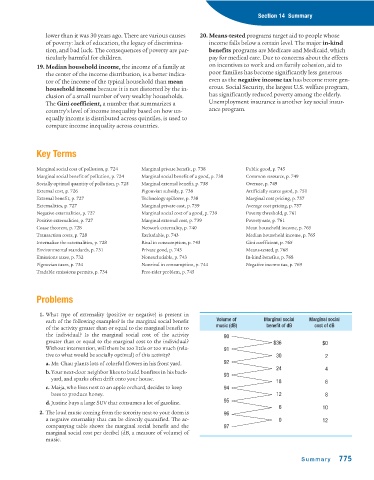Page 817 - Krugmans Economics for AP Text Book_Neat
P. 817
Section 14 Summary
lower than it was 30 years ago. There are various causes 20. Means-tested programs target aid to people whose
of poverty: lack of education, the legacy of discrimina- income falls below a certain level. The major in-kind
tion, and bad luck. The consequences of poverty are par- benefits programs are Medicare and Medicaid, which
ticularly harmful for children. pay for medical care. Due to concerns about the effects
19. Median household income, the income of a family at on incentives to work and on family cohesion, aid to
the center of the income distribution, is a better indica- poor families has become significantly less generous
tor of the income of the typical household than mean even as the negative income tax has become more gen-
household income because it is not distorted by the in- erous. Social Security, the largest U.S. welfare program,
clusion of a small number of very wealthy households. has significantly reduced poverty among the elderly.
The Gini coefficient, a number that summarizes a Unemployment insurance is another key social insur-
country’s level of income inequality based on how un- ance program.
equally income is distributed across quintiles, is used to
compare income inequality across countries.
Key Terms
Marginal social cost of pollution, p. 724 Marginal private benefit, p. 738 Public good, p. 745
Marginal social benefit of pollution, p. 724 Marginal social benefit of a good, p. 738 Common resource, p. 749
Socially optimal quantity of pollution, p. 725 Marginal external benefit, p. 738 Overuse, p. 749
External cost, p. 726 Pigouvian subsidy, p. 738 Artificially scarce good, p. 751
External benefit, p. 727 Technology spillover, p. 738 Marginal cost pricing, p. 757
Externalities, p. 727 Marginal private cost, p. 739 Average cost pricing, p. 757
Negative externalities, p. 727 Marginal social cost of a good, p. 739 Poverty threshold, p. 761
Positive externalities, p. 727 Marginal external cost, p. 739 Poverty rate, p. 761
Coase theorem, p. 728 Network externality, p. 740 Mean household income, p. 765
Transaction costs, p. 728 Excludable, p. 743 Median household income, p. 765
Internalize the externalities, p. 728 Rival in consumption, p. 743 Gini coefficient, p. 765
Environmental standards, p. 731 Private good, p. 743 Means-tested, p. 768
Emissions taxes, p. 732 Nonexcludable, p. 743 In-kind benefits, p. 768
Pigouvian taxes, p. 734 Nonrival in consumption, p. 744 Negative income tax, p. 769
Tradable emissions permits, p. 734 Free-rider problem, p. 745
Problems
1. What type of externality (positive or negative) is present in
each of the following examples? Is the marginal social benefit Volume of Marginal social Marginal social
music (dB) benefit of dB cost of dB
of the activity greater than or equal to the marginal benefit to
the individual? Is the marginal social cost of the activity 90
greater than or equal to the marginal cost to the individual? $36 $0
Without intervention, will there be too little or too much (rela- 91
tive to what would be socially optimal) of this activity? 30 2
a. Mr. Chau plants lots of colorful flowers in his front yard. 92
24 4
b.Your next-door neighbor likes to build bonfires in his back-
93
yard, and sparks often drift onto your house.
18 6
c. Maija, who lives next to an apple orchard, decides to keep 94
bees to produce honey. 12 8
95
d.Justine buys a large SUV that consumes a lot of gasoline.
6 10
2. The loud music coming from the sorority next to your dorm is 96
a negative externality that can be directly quantified. The ac- 0 12
companying table shows the marginal social benefit and the 97
marginal social cost per decibel (dB, a measure of volume) of
music.
Summary 775

